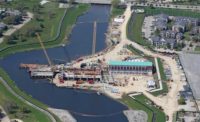Two, 550-ton sector gate leaves poised for installation next week in a $1.3-billion barrier being built to reduce risk of hurricane storm surge entering New Orleans’ vulnerable, eastern side, will plug a gaping hole in the city’s armor for the 2011 hurricane season.
On May 17, Massman Construction Co., Kansas City, Mo., is scheduled to begin installing the two 75-ft-wide, 42-ft-tall sector gate leaves that will form the armored door to a 150-ft-wide navigable passage through the northern end of the 1.8-mile-long barrier, which is know as the Inner Harbor Navigation Canal-Lake Borgne Storm Surge Barrier. It is part of a much larger defense system designed to reduce flood risk for the entire city.
When the gate is in place, the barrier will meet the U.S. Army Corps of Engineers design standards to reduce risk associated with a storm surge that has a one percent chance of occurring in any given year—often referred to as a 100-year storm.
“A lot of folks said it couldn’t be built,” says Col. (ret.) Vic Zillmer, Corps project manager on the IHNC. It is one of the largest features in the system, yet, by the end of April, the USACE and its contractors had completed roughly $980 million of the $1.1 billion construction cost of the +26 ft. elevation barrier.
Authorized by Congress in 2006, the IHNC barrier is designed to block smaller surges and reduce, or slow truly massive ones approaching from Lake Borgne and the Gulf of Mexico with heights greater than +26 feet, like the one that flooded portions of Orleans and St. Bernard parishes during Hurricane Katrina in 2005.
The IHNC surge barrier also includes a 150-ft-wide bypass barge gate, adjacent to the sector gate, and a 56-ft-wide vertical lift gate opening for recreational crafts where the barrier crosses Bayou Bienvenue. That gate is already set and is in the down and closed position. The barge gate—which is just that, a concrete-loaded barge designed to be intentionally submerged to block another opening in the event of a surge—will be on site by June 1 so it can be pulled into place if needed.
The sector gate is something of a marvel. “This sector gate has the highest storm design load of any structure in the world,” Zillmer says. “Our still water level is the same as the Dutch 10,000-year level. However, our wave load is much greater because we’ll have much bigger waves against the structure, and more of them.”
A joint venture of TetraTech INCA, Metairie, La. and Ben C. Gerwick, Oakland, Calif., designed the gate and supporting structure, which includes a 20-ft-wide ring wall curving from gate junctures to abutments to help the gate withstand tremendous storm surge loads.
The ring wall is 120 ft long and 42 ft high, from its sill under the channel to the roadway surface on top. It has a 3-ft-thick outer wall, a 2-ft-thick inner wall and 20-in.-thick connecting walls, Zillmer says.
“This type of wall was typical of fortified walls built in cities and castles for thousands of years, except the space between the inner and outer walls here is hollow due to weight considerations,” Zillmer says. But even hollow ring walls have precedent, he adds, such as one in a Biblical story about Jericho, which tells of a woman who lived inside the city wall and hid two spies there before lowering them out a window.








Post a comment to this article
Report Abusive Comment